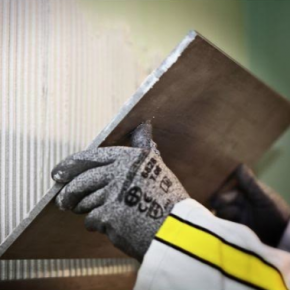
Saint Gobain Weber talks tiling over tiles
When tackling a refurbishment project, it can be a pain to remove the existing tiles before laying new ones, adding time and effort to the project. So can you tile over tiles? The answer is yes, but there are a few things to keep in mind when tiling on top of existing tiles. Here’s Saint Gobain Weber’s advice…
1. Pick which tiles to use
When tiling onto walls, it’s important to consider the surface behind the tiles and how much weight it will be able to carry. The most common background for tiles is plasterboard which can hold around 32kg/m², allowing for 3.5kg of adhesive and grout, and 28.5kg of tile per square metre.
Skimmed plasterboard, however, can only take around 20kg/m², so you’ll only have an allowance of 16kg/m² for tiles after adhesive and grout. With this in mind, consider the existing tiles – if the old tiles are quite heavy already, this will limit your choice of new ones. If you are looking to use larger, heavier tiles, you will likely need to remove the old ones first.
2. Prepare existing tiles
It’s important to first check that the existing tiles are well-bonded to the substrate. If not, the new tiles could cause the old ones to come loose. If the old tiles are suitably fixed, you can now proceed to preparing them for the job. If not, unfortunately, they’ll need to be removed.
Before beginning, check that the tiles are level. A grinder must be used to flatten any areas which stick out from the rest of the
surface. If the existing tiles have been sealed, the sealer will need to be removed for the adhesive to stick to the tile. Finally, the existing tiles need to be cleaned thoroughly and all dust removed. This is a crucial step as the new tiles may fail to adhere if the old ones aren’t suitably cleaned.
3. Fix new tiles
When the surface is ready for tiling, spread a layer of flexible adhesive such as weberset SPF or weberset rapid SPF onto the
surface of the existing tiles. If the new set of tiles are particularly large or are stud-backed, an additional layer of adhesive on the back of them may be required.
If tiling onto a heated floor, a flexible tile adhesive is a must to allow for expansion and contraction of the surface beneath the
tiles. A quartz tile will require an ultra-flexible S2 tile adhesive, such as weberset pro lite – rapid.
4. Finish with grout and sealant
Finish the job by filling the joints with a suitable tile grout such as weberjoint premium which is available in a range of 18 colours. Use weberjoint silicone sealant (colour-matched to our full range of grout colours, as well as clear option) to seal the edges.
Latest news

26th July 2024
Enfield Speciality Doors completes world-class project for Atlas Copco HQ
A rundown office and warehouse building completely transformed into a modern headquarters for Atlas Copco has been fitted with more than 120 internal fire doors from Enfield Speciality Doors.
Posted in Access Control & Door Entry Systems, Articles, Building Industry News, Building Products & Structures, Building Systems, Case Studies, Doors, Interior Design & Construction, Interiors, Posts, Restoration & Refurbishment, Retrofit & Renovation, Security and Fire Protection, Sustainability & Energy Efficiency, Timber Buildings and Timber Products, Wooden products
26th July 2024
Abloy UK launches new white paper
Abloy UK, a leading provider of security and access control solutions, has launched a new white paper.
Posted in Access Control & Door Entry Systems, Architectural Ironmongery, Articles, Building Industry News, Building Products & Structures, Building Services, Doors, Facility Management & Building Services, Health & Safety, Information Technology, Innovations & New Products, Publications, Research & Materials Testing, Security and Fire Protection
26th July 2024
MCRMA Member Profile: David Roy, Director of Roofconsult
David Roy of MCRMA member company Roofconsult has more than 50 years’ experience to draw upon working in the building envelope sector and a unique perspective on how it has changed in that time.
Posted in Articles, BIM, Infrastructure & CAD Software, Building Associations & Institutes, Building Industry News, Building Products & Structures, Building Services, Building Systems, Cladding, Information Technology, Restoration & Refurbishment, Retrofit & Renovation, Roofs, Walls
26th July 2024
Strand: Enhancing Door Functionality and Safety
Craig Fox, Sales Director for Strand Hardware, outlines how door industry professionals might apply door limiting stays…
Posted in Architectural Ironmongery, Articles, Building Industry News, Building Products & Structures, Building Services, Doors, Facility Management & Building Services, Health & Safety, Restoration & Refurbishment, Retrofit & Renovation
 Sign up:
Sign up: